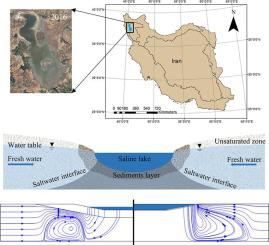当前位置:
X-MOL 学术
›
J. Hydrol.
›
论文详情
Our official English website, www.x-mol.net, welcomes your feedback! (Note: you will need to create a separate account there.)
Influence of lakebed sediment deposit on the interaction of hypersaline lake and groundwater: A simplified case of Lake Urmia, Iran
Journal of Hydrology ( IF 6.4 ) Pub Date : 2020-09-01 , DOI: 10.1016/j.jhydrol.2020.125110 Sorour Sheibani , Behzad Ataie-Ashtiani , Ammar Safaie , Craig T. Simmons
Journal of Hydrology ( IF 6.4 ) Pub Date : 2020-09-01 , DOI: 10.1016/j.jhydrol.2020.125110 Sorour Sheibani , Behzad Ataie-Ashtiani , Ammar Safaie , Craig T. Simmons

|
Abstract Lake Urmia, which was once the second-largest saline lake in the world, has been shrinking dramatically. Moreover, Lake Urmia has become supersaturated with total salinity averaging more than 350 g/l. Salt precipitation and dissolved materials brought by inflowing rivers have formed a layer of sediment with low hydraulic conductivity on the lakebed. Considering the flat bathymetry of Lake Urmia, we conducted a series of numerical simulation scenarios to study the groundwater flow pattern in the vicinity of the hypersaline Lake Urmia using COMSOL Multiphysics®. In the first step, we performed the simulations in steady-state conditions. Secondly, we simulated the lake level fall in 10 years at a rate of −35 cm/year followed by a lake level rise at a rate of 35 cm/year for another 10 years. The steady-state results demonstrate that decreasing sediment hydraulic conductivity layer and increasing its thickness lead to a less intense saltwater intrusion, with lower saltwater flux from the lake to the aquifer. As the lake level begins to fall, in cases with high sediment hydraulic conductivity, incoming saltwater from the lake decreases and reaches nearly zero values through the time; instead, the lake begins to get recharged. On the other hand, as the lake level begins to rise after the falling period, the saltwater flux from the lake to the aquifer increases and finally reaches a value of nearly two times greater than steady-state results. In low sediment hydraulic conductivity cases, incoming saltwater from the lake to the aquifer remains negligible through both rising and falling scenarios.
中文翻译:

湖底沉积物对高盐度湖泊与地下水相互作用的影响:以伊朗乌尔米亚湖为例
摘要 乌尔米亚湖曾经是世界第二大盐湖,现在却在急剧萎缩。此外,乌尔米亚湖已变得过饱和,总盐度平均超过 350 克/升。流入河流带来的盐分沉淀和溶解物质在湖床上形成了一层低导水率的沉积物。考虑到乌尔米亚湖的平坦水深测量,我们进行了一系列数值模拟场景,以使用 COMSOL Multiphysics® 研究高盐度乌尔米亚湖附近的地下水流动模式。在第一步中,我们在稳态条件下进行了模拟。其次,我们模拟了 10 年湖水位以 -35 厘米/年的速度下降,然后再以 35 厘米/年的速度上升 10 年。稳态结果表明,沉积物导水层的减小和其厚度的增加导致盐水入侵的强度降低,从湖泊到含水层的盐水通量降低。随着湖水位开始下降,在沉积物导水率高的情况下,从湖中流入的盐水会随着时间的推移而减少并接近零值;相反,湖泊开始充电。另一方面,随着湖泊水位在下降期后开始上升,从湖泊到含水层的咸水通量增加,最终达到稳态结果的近两倍。在低沉积物导水率的情况下,从湖泊流入含水层的盐水在上升和下降的情况下仍然可以忽略不计。
更新日期:2020-09-01
中文翻译:

湖底沉积物对高盐度湖泊与地下水相互作用的影响:以伊朗乌尔米亚湖为例
摘要 乌尔米亚湖曾经是世界第二大盐湖,现在却在急剧萎缩。此外,乌尔米亚湖已变得过饱和,总盐度平均超过 350 克/升。流入河流带来的盐分沉淀和溶解物质在湖床上形成了一层低导水率的沉积物。考虑到乌尔米亚湖的平坦水深测量,我们进行了一系列数值模拟场景,以使用 COMSOL Multiphysics® 研究高盐度乌尔米亚湖附近的地下水流动模式。在第一步中,我们在稳态条件下进行了模拟。其次,我们模拟了 10 年湖水位以 -35 厘米/年的速度下降,然后再以 35 厘米/年的速度上升 10 年。稳态结果表明,沉积物导水层的减小和其厚度的增加导致盐水入侵的强度降低,从湖泊到含水层的盐水通量降低。随着湖水位开始下降,在沉积物导水率高的情况下,从湖中流入的盐水会随着时间的推移而减少并接近零值;相反,湖泊开始充电。另一方面,随着湖泊水位在下降期后开始上升,从湖泊到含水层的咸水通量增加,最终达到稳态结果的近两倍。在低沉积物导水率的情况下,从湖泊流入含水层的盐水在上升和下降的情况下仍然可以忽略不计。


























 京公网安备 11010802027423号
京公网安备 11010802027423号